Answer these simple questions and we will find you the BEST prices
Which type of solar quotes do you need?
It only takes 30 seconds
100% free with no obligation

Tell us what you need to find a matching specialist

Get free quotes from professionals near you

Compare offers and choose the one that best matches your need
- whatcost.co.uk
- Home Insulation
- Wall Insulation
- Cavity Wall Insulation
- Retrofit Cavity Wall Insulation
Retrofit Cavity Wall Insulation: Complete 2025 Guide

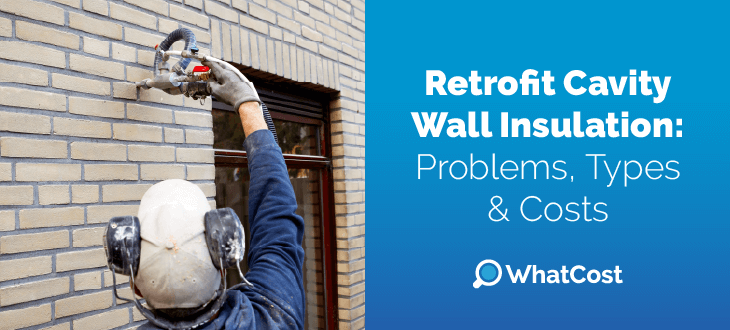
- Retrofit cavity wall insulation can cut your home heat loss by 35%, saving you upwards of 10% on your annual energy bills.
- The most effective kind of retrofit cavity wall insulation on the market today is EPS polystyrene beads.
- Typical costs for a retrofit cavity wall insulation are around £1,000 to £4,600 depending on your home type, size, and installation complexity.
Retrofitting cavity walls with insulation can significantly improve your home's energy efficiency, potentially reducing a staggering one-third of heat loss. This can save you up to £410 on annual energy bills and contribute to a more sustainable and eco-friendly living space.
However, choosing the right insulation materials, understanding the associated costs, and navigating potential grants can seem daunting. This article by WhatCost will guide you through the key considerations for retrofitting cavity wall insulation UK, including optimal materials, cost factors, and how to find the perfect installer for the job.
Ready to get cavity wall insulation? Let us land you the best bargains! All it takes is 30 seconds to fill out our simple online form, and we’ll send you 3 free home-tailored quotes directly from our network of pre-vetted professionals. No costs, no obligations. Just click below to begin!
- How does retrofit cavity wall insulation work?
- Different types of retrofit cavity wall insulation
- How much does retrofit cavity wall insulation cost?
- Common problems with retrofitting cavity wall insulation
- Advantages & disadvantages of retrofit cavity wall insulation
- Is retrofit cavity wall insulation worth it?
- FAQ
How does retrofit cavity wall insulation work?
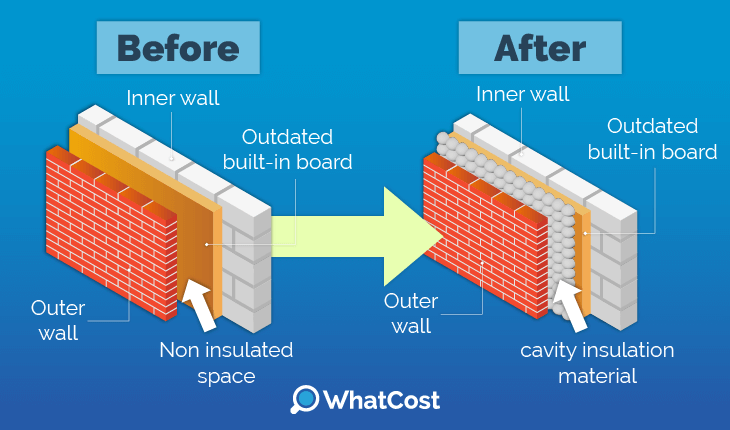
A cavity wall insulation retrofit involves filling the air gap within a cavity wall with insulating material. This significantly improves a home's energy efficiency, reducing heating costs and carbon emissions. Other benefits may include noise reduction and improved indoor air quality.
Retrofitting only applies to older homes and existing buildings, not new ones. It tends to be much simpler, requiring only exterior work and no invasive renovation work.
Here’s what the installation of cavity wall insulation looks like:
- Professional assessment: A qualified installer (preferably a member of the National Insulation Association or Cavity Insulation Guarantee Agency) should assess the walls and plan the installation. They can tailor the best course of action for your needs.
- Material selection: Choose the appropriate insulation material based on factors like wall type, home specifications, and budget. Common options include mineral wool, polystyrene beads, polyurethane foam, and blown cellulose.
- Installation: Small holes are drilled into the outer wall in spaced-out intervals to protect the wall's integrity. The insulating material is then injected into the cavity using specialised equipment. Once the cavity is filled, the drilled holes are sealed with cement for a seamless finish. The entire process typically takes a few hours.
We highly recommend working with a professional and accredited installer to ensure you get the best out of your investment. That way, the best action can be tailored specifically for your property.
Different types of retrofit cavity wall insulation
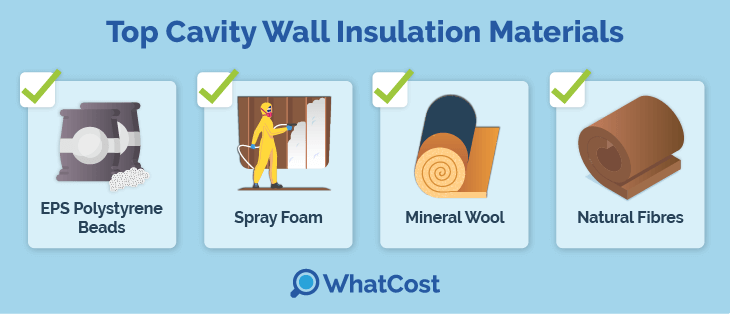
In today's market, there’s a wide range of insulation materials to choose from, but how do you decide what is best for cavity walls? Here’s a breakdown of the most popular types of retrofit cavity wall insulation available today:
- Expanded polystyrene (EPS) beads: EPS beads are a popular and affordable option for cavity wall insulation. They offer excellent resistance to moisture, making them suitable for older properties prone to dampness. Compared to other polymers, EPS beads are also relatively recyclable, and their cost makes them budget-friendly.
- Spray foam: Polyurethane foam is a versatile option known for its ease of installation. It can be injected into the cavity through several small holes, minimising disruption to the property. While polyurethane foam provides spectacular heat retention, the quality of foam can vary significantly. Lower-grade foams may degrade over time, impacting performance. It's crucial to choose high-quality foam for long-term effectiveness.
- Mineral wool: Typically made from stone or glass, mineral wool is available in various forms, including batts and slabs. For cavity wall insulation, loose fibres can be used for blown-in cavity wall insulation. Mineral wool is generally effective for insulating brick walls but may not be the best choice for properties with wooden elements, as it can be susceptible to moisture damage.
- Natural fibres: Natural fibres, such as sheep wool, offer an eco-friendly alternative to synthetic materials. They provide good insulation and help regulate moisture levels, making them suitable for properties with potential dampness issues. However, these materials can be more expensive than synthetic options and will require specific treatments to prevent insect infestation.
How much does retrofit cavity wall insulation cost?
On average, a cavity wall insulation retrofit can cost between £ 1,000 and £4,600, depending on the type and size of the home, the insulation materials chosen, and the installation complexity. Cavity wall insulation for a new build costs differently. In general, retrofit cavity wall insulation has a decent payback period of around 10 years, making the initial investment worthwhile for decades of comfort and savings ahead.
To make matters easier, here’s a breakdown of the average costs, savings and payback period for retrofit cavity wall insulation per home type:
| Home type | Average costs | Annual savings | Payback period |
| Apartment | £1,100 | £110 | 9 years |
| Mid terrace home | £1,500 | £140 | 11 years |
| Detached bungalow | £2,000 | £180 | 12 years |
| Semi-detached home | £2,700 | £240 | 11 years |
| Detached home | £4,300 | £410 | 11 years |
However, it’s important to keep in mind that these costs are simply market averages, and your final price tag can fluctuate based on a multitude of reasons. Here are some additional costs you may have to consider when getting retrofit cavity wall insulation:
- Chosen materials: The insulation material you move forward with will dictate a significant portion of your overall costs. For example, mineral fibres are much cheaper per m2 than spray foam. As a rule of thumb, the more expensive the material, the more effective it is at heat retention.
- Labour costs: On average, labourers charge around £15 - £20 per hour of installation work, but this cost can hinge on factors like your region or city. For example, residents of central London could pay more for labour costs than residents in the suburbs.
- Outstanding repairs: Retrofitting older houses almost always comes with preparatory work. This can be clearing out old insulation or debris from the cavity, relocating wires that pose a fire risk, or sealing any cracks or gaps in the older walls.
It’s good to keep in mind that cavity wall insulation soundproofing requires acoustic insulation materials and not thermal ones. Thermal insulation will not provide any significant degree of noise insulation.
If the prices for retrofit cavity wall insulation are too steep for you, not all is lost. You may be entitled to government support via an insulation grant scheme! The two main schemes in the UK are the Great British Insulation Scheme (GBIS) and the Energy Company Obligation (ECO4), both of which provide partial or full cost coverages for qualifying households.
Deciding on cavity wall insulation and applying for grant schemes is sadly not the end of the road. Finding the right installer at the right price can require countless hours of researching and vetting online. However, WhatCost can streamline this process for you.
With our services, it only takes 30 seconds to fill out our application form and get 3 free home-tailored quotes in return from our network of pre-vetted professionals. No costs or obligations apply. Simply click below to begin and let the bargains come to you!
Common problems with retrofitting cavity wall insulation
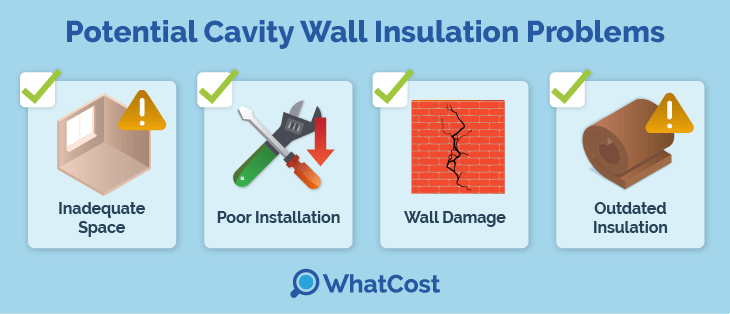
While cavity wall insulation offers significant benefits, it's crucial to be aware of potential issues that can arise, particularly when retrofitting older properties. That way, you can take necessary precautions to avoid any of these issues from occurring.
Here’s a breakdown of some potential problems with retrofitting cavity wall insulation:
- Inadequate cavity space: Older homes may have narrower cavity spaces than the recommended 50mm minimum. This can limit the effectiveness of insulation and potentially lead to installation challenges.
- Poor installation: Incorrect installation techniques, such as inadequate sealing or improper material selection, can result in a range of problems, including dampness, mould growth and overexposure to wind-driven rain that can exacerbate these issues.
- Wall damage: Cracks and gaps in the outer wall can allow water ingress, leading to insulation saturation and potential damage to internal wall surfaces.
- Outdated insulation: Older insulation types, such as those containing formaldehyde, may shrink over time and release harmful fumes. These materials should be removed and replaced with modern, safe alternatives.
While these problems may seem daunting, there are some practical steps you can take to ensure they don’t take place. Everything stems from your proactive decisions! Here are some key points to consider:
- Choose a CIGA-Guaranteed installer: Hiring an installer accredited by the Cavity Insulation Guarantee Agency (CIGA) provides peace of mind with a 25-year guarantee and helps ensure professional installation practices.
- Regular inspections: Conducting regular inspections of your walls for signs of dampness, mould, or other issues that may indicate problems with the insulation ensures that you identify problems before they become too serious.
- Address issues promptly: If any problems arise, deal with them immediately. Hire an installer to repair any cracks or gaps in the outer wall promptly to prevent water ingress.
In addition, numerous online resources and forums can guide in identifying potential issues with cavity wall insulation. If you suspect any problems, it's essential to consult with a qualified professional for a thorough inspection.
Advantages & disadvantages of retrofit cavity wall insulation
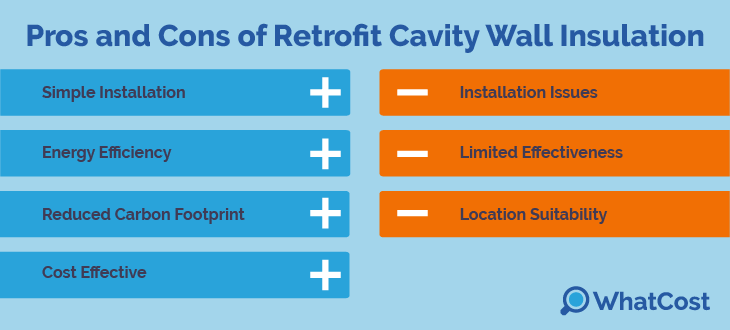
Retrofit cavity wall insulation offers a compelling solution for improving the energy efficiency of existing homes. However, like any home improvement project, it's crucial to understand both the advantages and disadvantages before making a decision.
To start with, let’s have a look at some of the perks that come with getting retrofit cavity wall insulation for your home:
- Simple installation: Cavity wall insulation is a relatively non-invasive process. It typically involves drilling small holes in the outer wall and injecting insulation material, causing minimal disruption to daily life and requiring little to no internal renovations. The installation process is also quick and often completed within a few hours.
- Improved energy efficiency: By reducing heat loss, cavity wall insulation significantly lowers energy consumption, leading to substantial savings on heating bills. For a detached home, this can translate to £410 every year!
- Reduced carbon footprint: Lower energy consumption translates to reduced carbon emissions, making it an environmentally friendly home improvement option.
- Cost-effective: Compared to more extensive renovations like replacing the heating system, cavity wall insulation offers a relatively affordable solution for energy efficiency.
While retrofit cavity wall insulation problems rarely occur, here are some potential pitfalls to keep an eye out for:
- Installation issues: Poorly installed cavity wall insulation can lead to serious problems, including dampness, mould growth, and even structural damage. It's crucial to choose a reputable and experienced installer.
- Limited effectiveness: In some cases, external wall insulation may offer better energy efficiency improvements.
- Location suitability: Homes exposed to heavy rain or high winds may be more susceptible to moisture ingress, potentially negating the benefits of cavity wall insulation. In such cases, alternative solutions like internal wall insulation may be more appropriate.
All in all, retrofit cavity wall insulation presents a viable option for enhancing the energy efficiency of existing homes. Its non-invasive nature, speed of installation, and potential for significant energy savings make it an attractive prospect for many homeowners.
Consulting with qualified professionals and obtaining multiple quotes from reputable installers is crucial to ensure a successful and beneficial outcome.
Is retrofit cavity wall insulation worth it?
Retrofitting cavity wall insulation can offer significant benefits for homeowners, particularly in terms of reduced energy consumption and lower heating bills. Studies show that cavity wall insulation can decrease energy consumption by 10%, translating to potential annual savings of up to £410 depending on the size and energy usage of your home.
While an initial cavity wall insulation price can range between £1,000 - £4,600, government grant schemes can significantly offset these expenses. The ECO4 and the Great British Insulation Scheme offer financial assistance to eligible low-income households.
Does cavity wall insulation need renewing? Absolutely. If installed properly, cavity wall insulation should deliver around 25+ years of efficient heat retention, with some reports claiming up to 100 years.
Regularly checking your insulation with a professional can help prolong its lifespan.
The next step is to find a reputable installer to work with, why you ask? Here are just some of the key benefits that come with a professional insulation expert:
- Thorough assessment: Wondering how to check cavity wall insulation? Preemptively identifying and solving potential issues with a professional can ensure your walls are suitable for insulation and free of damage.
- Home-tailored approach: Create an efficient and cost-effective plan based on your property's specific needs and characteristics.
- Accurate quotes: Have a complete understanding of your spending, including any necessary repairs or adjustments.
- Professional workmanship: Maximise the effectiveness and longevity of the insulation with a high-quality job and CIGA guarantee of up to 25 years.
Finding a reputable insulation expert can be very time-consuming. Luckily, WhatCost’s quick and easy service can help you connect with qualified professionals in your area. Just spend 30 seconds filling out our online form, and we’ll send you 3 free home-tailored quotes from our pre-vetted professionals. Click below to begin and let the bargains come to you!
FAQ
Currently, the most effective insulation material for retrofitting cavity walls is EPS polystyrene beads. This is because their moisture and mould resistance makes them particularly reliable when insulating older homes that may exhibit condensation issues.
Retrofitting wall insulation is worth it. By cutting your home heat loss by up to 35%, you can expect significant energy bill savings, prolonged home comfort, and a slashed carbon footprint that benefits you and the planet at large.
To retrofit a cavity wall, insulation installers drill small holes in the outer wall and inject insulation material into the cavity space using specialised industry equipment. Once filled, the holes are sealed with cement for a seamless finish.
Retrofitting insulation in cavity walls involves adding insulation material to the cavity space of such properties after the property has been built. In other words, you do not retrofit cavity wall insulation to new builds, only old builds.

Akif has a keen interest in green home improvement solutions and the role of digital media in identifying climate trends. He aims to provide a multidisciplinary approach to content rooted in credible research and accuracy.
- Retrofit Cavity Wall Insulation: Complete 2025 Guide
- How does retrofit cavity wall insulation work?
- Different types of retrofit cavity wall insulation
- How much does retrofit cavity wall insulation cost?
- Common problems with retrofitting cavity wall insulation
- Advantages & disadvantages of retrofit cavity wall insulation
- Is retrofit cavity wall insulation worth it?
- FAQ
